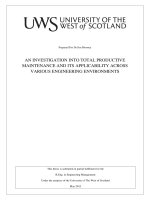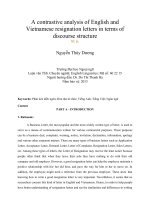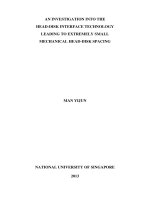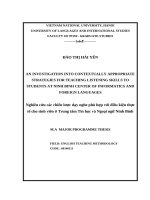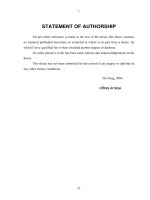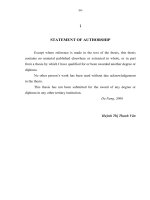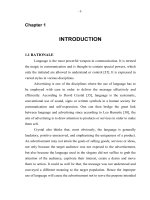An investigation into code switching on facebook social network by english vietnamese bilingual users in the author’s friend list from socio linguistic approach
Bạn đang xem bản rút gọn của tài liệu. Xem và tải ngay bản đầy đủ của tài liệu tại đây (898.23 KB, 82 trang )
VIETNAM NATIONAL UNIVERSITY, HANOI
UNIVERSITY OF LANGUAGES AND INTERNATIONAL STUDIES
FACULTY OF POST-GRADUATE STUDIES
---------------------
DƢƠNG THỊ HỒNG THẮM
AN INVESTIGATION INTO CODE SWITCHING ON
FACEBOOK SOCIAL NETWORK BY ENGLISH-VIETNAMESE
BILINGUAL USERS IN THE AUTHOR’S FRIEND LIST FROM
SOCIO-LINGUISTIC APPROACH
(NGHIÊN CỨU VỀ HIỆN TƢỢNG CHUYỂN NGỮ TRÊN MẠNG
XÃ HỘI FACEBOOK BỞI NHỮNG NGƢỜI THÔNG THẠO HAI
NGOẠI NGỮ ANH-VIỆT TRONG DANH SÁCH BẠN BÈ CỦA
TÁC GIẢ THEO ĐƢỜNG HƢỚNG NGÔN NGỮ HỌC XÃ HỘI)
M.A. MINOR PROGRAMME THESIS
Field: English linguistics
Code: 60220201
HANOI - 2016
VIETNAM NATIONAL UNIVERSITY, HANOI
UNIVERSITY OF LANGUAGES AND INTERNATIONAL STUDIES
FACULTY OF POST-GRADUATE STUDIES
--------------------DƢƠNG THỊ HỒNG THẮM
AN INVESTIGATION INTO CODE SWITCHING ON
FACEBOOK SOCIAL NETWORK BY ENGLISH-VIETNAMESE
BILINGUAL USERS IN THE AUTHOR’S FRIEND LIST FROM
SOCIO-LINGUISTIC APPROACH
(NGHIÊN CỨU VỀ HIỆN TƢỢNG CHUYỂN NGỮ TRÊN MẠNG
XÃ HỘI FACEBOOK BỞI NHỮNG NGƢỜI THÔNG THẠO HAI
NGOẠI NGỮ ANH-VIỆT TRONG DANH SÁCH BẠN BÈ CỦA
TÁC GIẢ THEO ĐƢỜNG HƢỚNG NGÔN NGỮ HỌC XÃ HỘI)
M.A. MINOR PROGRAMME THESIS
Field: English linguistics
Code: 60220201
Supervisor: Dr. Đỗ Thị Thanh Hà
HANOI - 2016
DECLARATION
I hereby, certify the thesis entitled “An investigation into code switching on
Facebook social network by English-Vietnamese bilingual users in the author‟s
friend list from socio-linguistic approach” is the result of my own research for the
Minor Degree of Master of Arts at University of Languages and International
Studies, Vietnam National University, Hanoi. The thesis has not been submitted for
any degree at any other universities or institutions. I agree that the origin of my
paper deposited in the library can be accessible for the purposes of study and
research.
September, 2016
Dƣơng Thị Hồng Thắm
i
ACKNOWLEDGEMENTS
I would like to show my gratitude to all those who gave me the possibility to
complete this thesis.
I have sincere thanks to all of the informants, or the people on my friend list
on Facebook for giving me permission to to use, analyze as well as cite their
comments and statuses. Especially, they were all enthusiastic, helpful, and gave me
valuable answers.
I am deeply indebted to my supervisor, Dr. Đỗ Thị Thanh Hà, whose
encouragement, guidance and support enabled me to develop an understanding of
the subject and to accomplish the final version of the thesis as expected.
This thesis would not have be possible but for my lecturers in the M.A. course,
namely Prof. Dr. Hoàng Văn Vân, Assoc. Prof. Dr. Lê Hùng Tiến, Dr. Nguyễn Huy
Kỷ, Dr. Ngô Hữu Hoàng, and Dr. Huỳnh Anh Tuấn. I would like to thank them for
their interesting lectures, devotion, assistance and valuable hints.
Especially, I owe my deepest gratitude to my family, friends, and colleagues
whose encouragement helped me finish this work.
Last but not least, I offer my regards to all of those who supported me in any respect
during the completion of the study.
ii
ABSTRACT
Nowadays, with the outburst of computer-mediated communication (CMC) like
the social network Facebook, or Twitter, English language gets many variables. One
of the most interesting phenomena is that bilingual speakers usually tend to switch
some words or phrases from one language to another during conversation or written
form, which is called code-switching. This research looks at the status updates and
comments which contain tokens of code switching and are published on Facebook
site of its users in the author‟s friend list. The thesis aims to investigate the types of
and reasons for code-switching found in conversations between the participants,
using the typology suggested by Poplack (1980) and reasons proposed by Malik
(1994). Results show that instances of intra-sentential code-switching were
dominant and the most common reason is habitual expression.
iii
LIST OF TABLES AND ABBREVIATIONS
ABBREVIATIONS
L1: First language
L2: Second language
SNS: Social network sites
CMC: Computer-Mediated Communications
TABLES
Table 1: Breakdown of detected code-switching instances according to Poplack‟s
(1980) typology ......................................................................................................... 25
Table 2:Breakdown of intra-sentential code-switching by syntactic category ......... 26
Table 3: Breakdown of other word classes ............................................................... 27
Table 4: Switched nouns and noun phrases by semantic category ........................... 30
Table 5: Switched verbs, phrasal verbs and verb phrases by semantic category ...... 31
Table 6: Analysis of sentence-boundary inter-sentential code-switching ................ 37
Table 7: Breakdown of specific reasons for code-switching (proposed byMalik
1994) ......................................................................................................................... 29
iv
TABLE OF CONTENTS
Declaration ................................................................................................................ i
Acknowledgements ................................................................................................... ii
Abstract ..................................................................................................................... iii
List of tables and abbreviations................................................................................. iv
CHAPTER 1: INTRODUCTION ......................................................................... 1
1.1. Rationale ........................................................................................................ 1
1.2. Purpose of the study ....................................................................................... 1
1.3. Research questions ......................................................................................... 2
1.4. Significance of the study ................................................................................ 2
1.5. Scope of the study .......................................................................................... 3
1.6. Outline of the thesis ....................................................................................... 3
CHAPTER 2: LITERATURE REVIEW ............................................................. 4
A. THEORETICAL BACKGROUND .................................................................... 4
2.1. Code, code-switching, code-mixing............................................................... 4
2.1.1. Code .......................................................................................................... 4
2.1.2. Code-switching ......................................................................................... 4
2.1.2.1. Definitions .............................................................................................. 4
2.1.2.2.Types of code-switching ......................................................................... 5
2.1.2.3.Why do people code-switch? .................................................................. 6
2.1.3. Code-switching and code-mixing .............................................................. 9
2.1.4. Code-switching and lexical borrowing ...................................................... 11
2.2. Linguistic constraints on code-switching ....................................................... 12
2.3. Bilingualism .................................................................................................... 14
2.4. Sociolinguistics ............................................................................................... 15
2.5. Facebook ......................................................................................................... 15
2.6. Language on Facebook. .................................................................................. 16
B. PREVIOUS STUDIES ........................................................................................ 16
CHAPTER 3: METHODOLOGY ........................................................................ 20
3.1. Research hypothesis ....................................................................................... 20
v
3.2. Participants ..................................................................................................... 20
3.3. Data corpus description .................................................................................. 21
3.4. Methods of data collection ............................................................................. 21
3.5. Coding scheme ............................................................................................... 22
3.6. Methods of data analysis ................................................................................ 23
3.7. Procedure ........................................................................................................ 24
3.8. Recapitulation ................................................................................................. 25
CHAPTER 4: FINDINGS AND ANALYSIS ...................................................... 27
4.1. Introduction .................................................................................................... 27
4.2. Research question 1: What are the types of code-switching found in the
data.. ...................................................................................................................... 27
4.2.1. Classification of detected instances of code-switching according to
Poplack‟s (1980) typology ................................................................................ 27
4.2.2. Estimation of instances of intra-sentential code-switching by syntactic
category ............................................................................................................. 28
4.2.3. Description of intra-sentential code-switching by syntactic category..30
4.2.3.1.Nouns and noun phrases ........................................................................ 30
4.2.3.2.Verbs and verb phrases .......................................................................... 32
4.2.3.3. Adjectives ............................................................................................. 34
4.2.3.4. Adverbs ................................................................................................. 34
4.2.3.5. Prepositions and prepositional phrase .................................................. 34
4.2.3.6. Sentence ................................................................................................ 35
4.2.3.7. Interjection ............................................................................................ 32
4.2.3.8. Rules violated cases .............................................................................. 36
4.2.3.9. Special cases ......................................................................................... 36
4.2.3.9.1. Vocabulary transcribed from English into Vietnamese .................... 37
4.2.3.9.2.The use of qualifier and to-infinitive .................................................. 37
4.2.3.9.3. Vietnamese switched words ............................................................... 37
4.2.4. Extra-sentential code-switching .............................................................. 38
4.2.5. Inter-sentential code-switching ............................................................... 38
vi
4.3. Research question 2: What are the reasons for the use of code-switching in
general and in specific instances? ......................................................................... 40
4.4. Discussion ...................................................................................................... 49
CHAPTER 5: CONCLUSION ........................................................................... 50
5.1. Recapitulation ................................................................................................. 50
5.2. Limitations of the study.................................................................................. 51
5.3. Suggestions for further studies ....................................................................... 52
REFERENCES .................................................................................................... I
APPENDIX A ...................................................................................................... IV
APPENDIX B ..................................................................................................... XIII
vii
CHAPTER I: INTRODUCTION
1.1.
RATIONALE
English which is widely considered the international language and spoken by
innumerable people has become the primary communication tool for many
purposes. The ISO 3166-1 code lists 83 countries and regions with English as
"official language". (ISO 3166-1 Codes for the representation of names of countries
and their subdivisions.) At present, up to 1.8 billion people around the world speak
English, thus it is the most widely used "second" and "learning" language in the
world used for international communication in various fields like aviation, business,
internet, science and technology to name only some. Therefore, learning English is
now becoming more popular than ever before in Vietnam. One of the most
interesting things to note is that for people who know English, especially those
studying, living abroad or using different languages other than their mother tongue
have a tendency to mix the two languages, i.e. English and Vietnamese, in
conversation as well as in written contexts. Code-switching, the practice of moving
back and forth between two languages or between two dialects or registers of the
same language, therefore is inevitable and sometimes unconscious, especially when
people, especially youngsters, join social networks. For example, it is not surprising
to see a status update on Facebook which contains switched words, phrases, or
sentences. Moreover, the frequency of finding code-switching practice on Facebook
sites is quite high and the influence of language use on Facebook users is becoming
much greater. Therefore, this thesis aims to provide some background knowledge
about the patterns of code switching used on Facebook, the reasons why bilinguals
code-switch and lay foundation for further studies.
1.2.
PURPOSE OF THE STUDY
Nowadays, when English is required as a second language in our society, Code
Switching occurs in every field of daily life: from daily conversation to news,
interview, discussion on television, on radio as well as newspapers, magazines and
so on. The special phenomenon had been previously researched as the matter of
bilingualism. Therefore, once choosing and carrying out this study, I have two main
objectives as follows:
1
1. To find out what type of code-switching is most commonly used by EnglishVietnamese bilinguals in the author‟s friend list.
2. To investigate the reasons for code-switching.
1.3.
RESEARCH QUESTIONS
The study aims at seeking answers to the following questions:
1. What are the types of code-switching in bilinguals‟ Facebook status updates
and comments?
2. What are the reasons for the use of code-switching in general and specific
instances?
1.4.
SIGNIFICANCE OF THE STUDY
Sociolinguistics studies the relationship between language and society. They are
interested in explaining why people speak differently in different social contexts,
and concerned with identifying the social functions of language and the way it is
used to convey social meaning. Examining the way people use language in different
social contexts provides a wealth of relationships in a community and the way
people signal aspects of their social identity through their language. (Holmes:2001).
Moreover, in a bilingual or multilingual society, it is normal for people to be in the
situation where a change between two or more languages has to be made. That
phenomenon is called code-switching. For bilingual speakers, code-switching is a
valuable tool for various reasons. The alternation between two languages in the
form code switching is widely observed in many settings and in many speech
communities. However, it is an under-researched and rather new issue on Facebook
which the paper attempts to look into. Thus, once completed, its outcome may offer
benefits to entities involved, namely English-Vietnamese bilinguals, linguists and
teachers in general; and Facebook users who are in favor of code-switching, in
particular. This study partly helps them to get better understanding of code
switching, the phenomenon that they often use but have little idea about. Moreover,
the study helps find out the practice of switching between the two languages
Vietnamese and English, how these users employ code switching mechanism to
organize, enhance and smoothen their writings. More importantly, the paper helps
figure out the reasons why Facebook users code-switch.
2
In addition, researchers of the related fields can use the current paper for reference
and carry out further and deeper investigation as it will add to the existing literature
on code-switching, specifically on computer-mediated written form. It is important
as bilinguals will then be aware of the phenomenon that may occur during online
communication via social net-working websites such as Facebook.
1.5.
SCOPE OF THE STUDY
This study focuses on the phenomenon of code-switching used on Facebook sites of
ten bilinguals in the author‟s friend list. Although there are several applications for
Facebook users to communicate on this social network such as private and public
message, status, comment, note, chat, voice and video call and so on, some of them
are hard to elicit. As a result, only status updates and comments have been taken
into consideration, which means this work only examines patterns of codeswitching in written form.
1.6. OUTLINE OF THE THESIS
The rest of the study consists of four chapters which are as follows.
Chapter two, Theoretical Background, reviews prominent literature directly relevant
to the topic being discussed.
Chapter three, Methodology, presents the methods used for data collection and data
analysis as well as justification for these methods.
Chapter three is followed by the fourth chapter, Results and Discussion, in which
the findings of the study are discussed to answer the research questions.
Finally in chapter five, recapitulation of the whole study is presented before
limitations of the study; suggestions for further studies and a conclusion are given.
3
CHAPTER II: LITERATURE REVIEW
A-THEORETICAL BACKGROUND
2.1. Code, code-switching, code-mixing
2.1.1. Code
The term “code” is used by sociolinguists as a less popular name for “variety of
language”, or just “variety” for short, which can be defined as “a set of linguistic
items with similar social distribution” (Hudson, 1996, p. 22). The very general
notion “variety” includes languages, dialects and registers (Hudson, 1996). Sharing
this view, Holmes (2008, p.7) concedes that:
A variety is a set of linguistic forms used under specific social circumstances,
i.e., with a distinctive social distribution…which includes different accents,
different linguistic styles, different dialects and even different languages
which contrast with each other for social reasons.
The definitions by both authors show an emphasis on the speech community in
which a variety is used, and on the linguistic items as components. In the context of
this study, the term “code” or “variety” will be taken as the first language used by
speakers of a country.
2.1.2 Code-Switching
2.1.2.1. Definitions
There are many different ways to define the phenomenon as a result of different
research interest as well as how researchers view it. According to Haddock (2008),
code switching is the “consciously modifying speech to slip from one culture to
another.” McCoy (2006, p.24), from different viewpoint, sees the phenomenon as
the “change from lexical register to another”. Knestrict & Schoensteadt (2005,
p.177) refer to the “Shift in language that is guided by a shift in context” while
Hughes, Shaunessy, and Brice (2006, p.8) define it as the “use of complete
sentences, phrases, and borrowed words from another language”.
To be more specific, code switching is created by those who live in or use different
languages other than their mother tongue can switch from one language to another
during interaction.
4
Shana Poplack (1980, p.231), a very influential linguistics, simply defines codeswitching as “the alternation of two languages within a single discourse, sentence or
constituent”, often with no change of interlocutor or topic. Simple as it may seem,
this definition lists in descending order the possible places at which code-switching
may occur, namely discourses, sentences, and constituents. Besides, Poplack only
uses the term “code-switching” for all cases of code alternation, which can exist
below, at, or above sentence level. The author bases on this definition to detect
tokens of code-switching.
2.1.2.2. Types of code switching
Bloom and Gumperz (1972) distinguishes two types of code-switching called
situational and metaphorical code-switching, on the basis of sociolinguistic factors.
In Bloom and Gumperz‟s (1972, p. 424-425) view, situational switching takes place
in cases where speakers switch languages due to a change in the situation, such as a
change in participant, topic or setting. In short, situational code-switching occurs
when the choice of language depends on the situation. In contrast, metaphorical
switching refers to cases when the choice of language determines the situation,
“because the speaker decides to ignore the observable external situation and focus
instead on less observable characteristics of code-switching of the people
concerned” (Hudson, 1996, p.53). Metaphorical code-switching can be employed as
a conversational strategy to assist conversational acts such as apologizing or
requesting.
From another perspective, Poplack (1980) divided code switching into three types
including extra-sentential (tag switching), inter-sentential and intra-sentential ones.
The first type, extra-sentential code-switching, or tag switching relates to the
inclusion of a tag phrase or a word, or both; for example, we can use “Ok”,
“Right?” “I mean” or “You know” into an utterance or sentence that is otherwise
entirely in another language. This type of code-switching is very simple and does
not require a great command of both languages, since there is a minimum risk of
violation of grammatical rules.
The second type, inter-sentential switching, occurs in clause level or between
sentences. Switching at clause boundary means that one clause is in one language,
5
while the other clause is in another, e.g. “Sometimes I‟ll start a sentence in English
y termino en espanol” (“Sometimes I‟ll start a sentence in English and finish in
Spanish”) (Spanish-English bilingual recorded by Poplack (1980) in the Puerto
Rican community of New York city). As for sentence boundary, it is not surprising
if we experiences sentences like “What a brilliant idea!!! Ôi mình sẽ tìm mọi cách
mua cái bình nước này.”
The third type, intra-sentential switching occurs within the clause boundary. In
Spanish-English switching one could say, "La onda is to fight y jambar." ("The inthing is to fight and steal."). This is considered the most complicated type of codeswitching, mainly because of the high probability of violation of syntactic rules, as
well as the requirement of a great knowledge of both languages and how they can
map onto each other.
So far, Poplack‟s typology has been regarded as the most transparent and
comprehensive one that covers all cases of code-switching without causing much
confusion. Therefore, it will be used as the conceptual framework to classify types
of code-switching found in recorded statuses and comments in this study.
2.1.2.3. Why do people code switch?
Code switching often happens to bilinguals. As we realize, there are some reasons
why bilinguals code switch, with some reasons being conscious and some being
unconscious. Research has found that bilinguals code switch to convey or clarify
meaning, learn new vocabulary, and help create a sense of ethnic identity and
community. Since code-switching is motivated by situations, the speakers may use
it to identify with a particular group of people (Hughes et al., 2006). Also, it can be
a sociolinguistic tool, used for clarification, emphasis, separation from feelings, and
achievement of a dramatic effect (Hughes et al., 2006). By giving the speakers more
ways to communicate, code-switching is a useful tool in the bilingual community.
Some researchers also found out that students code switch when their knowledge of
the target language was insufficient, or when there is a communication breakdown,
to establish inter-subjectivity or because the pragmatic meaning of a word cannot be
translated into the second language. In this section, I will mention some research
6
findings for why people code switch. Speakers may switch from one code to
another either to show solidarity with a social group, to distinguish oneself, to
participate in social encounters, to discuss a certain topic, to express feelings and
affections, or to impress and persuade the audience.
Appel and Muysken (2006) suggest that code-switching perform six main functions
as follows:
1. Referential function: code-switching stems from the lack of knowledge or facility
in a language. Therefore, bilingual speakers switch code when they do not know the
word or when a certain concept is not available in that language. Moreover,
language is chosen to code-switch due to the fact that it is more suitable to be used
for a particular topic.
2. Directive function: This participant-related function of code-switching aims to
include or exclude a person from part of a conversation such as by using a familiar
or foreign language to that person.
3. Expressive function: Speakers use more than one language to stress their selfidentity or feelings to others in the conversation.
4. Phatic function: code-switching is used to show a change in tone and emphasize
important parts of a conversation.
5. Metalinguistic function: Bilinguals sometimes code-switch in order to comment
on another language. In other words, this function is most marked when the speaker
or writer quotes words, phrases or sentences in another language in order to
preserve the original meanings and senses of the quotations.
6. Poetic function: Words, puns, and jokes in one language are switched to another
language for the purpose of amusement or entertainment.
Discussing the sociolinguistics of code-switching, Gumperz (1982, p. 144)
lists examples of situations created to convey meaning as given below:
- to appeal to the literate
- to appeal to the illiterate
- to convey precise meaning
- to ease communication, i.e., utilizing the shortest and the easiest route
- to negotiate with greater authority
7
- to capture attention, i.e. stylistic, emphatic, emotional
- to emphasize a point
- to communicate more effectively
- to identify with a particular group
- to close the status gap
From the perspective of sociolinguistics, Malik (1994) explained ten reasons for
speakers to code-switch:
1. Lack of facility: When certain concepts in a language do not exist in another,
bilinguals
switch
code
to
express
themselves
and
avoid
unnecessary
misunderstanding and loss of intended meaning as well.
2. Lack of registral competence: Bilinguals choose to codeswitch when they find it
hard to choose appropriate words in the target language for specific topics.
Moreover, they may not be equally competent in the two languages.
3. Mood of the speaker: When bilinguals are in different moods such as tired, angry,
or nervous, they may employ the practice of code-switching. Even if the intended
words are available in the two languages, bilinguals still choose to code-switch
when the ones in the other language seem to take less time and effort to be used.
4. To amplify and emphasize a point: Speakers apply code-switching on selected
parts of a speech to make sure that listeners know what to focus on and highlight in
situations.
5. Habitual expressions: Code-switching also appears in fixed phrases of greetings,
partings, commands, requests, invitation, apologies and discourse markers.
6. Semantic significance: Code-switching can deliver essential and meaningful
linguistic as well as social information. Hence, listeners interpret code-switching as
an indicator of the speaker‟s communicative intents, emotions and attitude.
7. To show identity with a group: To people of a same group or culture, codeswitching is used to signify shared values and experiences. As a result, words and
phrases are kept in their original languages to express a sense of familiarity and
belonging to the group.
8
8. To address different audience: When targeted to different listeners or recipients,
different languages are used to convey messages, just similar to Gumperz‟s (1982)
addressee specification,
9. Pragmatic reasons: Sometimes, code-switching depends on the context of a
conversation or other factors such as formality, participants and location where a
conversation takes place. Thus, code-switching may portray a varying degree of
speakers‟ involvement.
10. To attract attention: Usually, when two or more languages are used in the media
or advertisements, audiences are more attracted to the language that they are
familiar with first.
Although a variety of functions of and reasons for code-switching have been
suggested by many linguists, ten reasons described by Malik (1994) appear to be
most succinct yet comprehensive. In the context of this study, where participants
are asked to give reasons for their code-switching, ten reasons proposed by Malik
(1994) will be employed as the theoretical framework in analyzing the collected
data for their comprehensiveness and intelligibility to readers.
2.1.3. Code switching and code mixing
The distinction between code-switching and code-mixing is one of the most
intriguing issues in the study of code alternation. Clyne (1991, p.161) argues that
code-switching and code-mixing refer to the same phenomena in which “speaker
stops using language „A‟ and employs language „B‟”. Other researchers, however,
attempt to distinguish between code-switching and code-mixing. One approach
investigating this issue from a grammatical perspective is to base on the place where
the alternation takes place. According to Wei (1998), if code alternation occurs at
or above clause level, it is considered code-switching, but if it occurs below clause
level then it is called code-mixing.
Following the same approach, Muysken (2000) uses the term “code-mixing” to
refer to “all cases where lexical items and grammatical features from two languages
appear in one sentence” (p.1), which he calls “intra-sentential code-mixing”. He
reserves the term “code-switching” for “the rapid succession of several languages in
a single speech event”. Similarly, Bhatia and Ritchie (2004) concedes that code9
mixing refers to the mixing of various linguistic units (morphemes, words,
modifiers, phrases, clauses and sentences) primarily from two participating
grammatical systems within a sentence. It can be inferred from the similarity in the
three definitions by Wei, Muysken and Bhatia and Ritchie that the phenomenon of
code-mixing occurs within a sentence, which leaves the inter-sentential places for
code-switching.
The view of Poplack (1979/1981) bears little resemblance to the above-mentioned
ones. Poplack only uses the term “code-switching” for all cases of code alternation,
which can exist below, at, or above sentence level. More about this idea shall be
discussed in the next section.
While the first approach rests on the point of code alternation as a criterion to
distinguish between code-switching and code-mixing, the second one viewing this
from a sociolinguistic perspective is more concerned with extra-linguistic factors.
For example, Hudson (1996, p. 53) says that in code-switching, “the point at which
the languages change corresponds to a point where the situation changes, either on
its own or precisely because the language changes.” Conversely, he views codemixing as a case “where a fluent bilingual talking to another fluent bilingual
changes language without any change at all in the situation.”, and gives it the name
of “conversational code-switching”, which he finds “a rather unhelpful name”.
Obviously, Hudson bases his distinction on the speakers‟ code choice according to
changes in situation, which sounds fairly abstract, since the notion of “situation”
and “situational changes” need further clarification. What are factors determining a
situation and what are possible situational changes that may affect one bilingual‟s
code choice?
Another extra-linguistic factor used to differentiate code-switching from codemixing is suggested by Holmes (2008, p. 43). She argues that code-mixing suggests
“the speaker is mixing up codes indiscriminately or perhaps because of
incompetence”, whereas code-switching should be identified as rapid switching in
which “switches are very well motivated in relation to the symbolic or social
meanings of the two codes”. She recommends the name “metaphorical switching”
for the latter phenomenon. Accordingly, what Holmes uses as criterion of
10
distinction is speaker-related factors, such as intention or language competence.
Again, this viewpoint is not without weakness, mainly because speaker‟s intention
or language competence is something that cannot be examined easily. Even a
bilingual with limited language proficiency can still rapidly code-switch with an
implication.
Consequent to the discussion of two approaches to distinguishing code-switching
and code-mixing, it can be concluded that the first one using point of code
alternation as criterion is more clear-cut and is likely to work in examining
conversations. Thus, it is the first approach that this study will follow, and the
theory by Poplack (1979/1981) will be used as the framework to identify tokens of
code-switching in the study. In other word, this study will use the term codeswitching to refer to both code-switching and code-mixing, while the three terms
intra-sentential code-switching, inter-sentential code-switching and extra-sentential
code-switching are adopted to determine the types of code-switching.
2.1.4. Code-switching and lexical borrowing
As regard the definition of borrowing, Hamers and Blanc (2000, p. 259) considers
borrowing as “the adaptation of lexical material to the morphological, syntactic and,
usually (but not always), phonological patterns of the recipient language”. Sharing
this view, Myers-Scotton (2002, p. 234) describes borrowing as an adoption of a
linguistic feature previously used in another, and also calls borrowing “loan words”.
Many researchers suggest that code-switching and borrowing are not completely
different. For instance, Romaine (1994, as cited in Hamers and Blanc, 2000, p. 259)
suggests that: “Borrowings may look like code-switches in that they retain a foreign
status (especially in phonology), while code-switches often resemble borrowings in
brevity and in being fitted into the syntax of another language.”
However, these two language contacts are often viewed as distinct phenomena.
thinks we can base on the level of the destination where these phenomena take
place. According to Hudson (1996, p. 55), whereas code-mixing and code-switching
involve “mixing language in speech”, borrowing involves “mixing the systems
themselves, because an item is „borrowed‟ from one language to become part of the
other language.” Myers-Scotton (2002) views each as placed at the opposite ends of
11
a continuum based on frequency of use. She suggests that borrowings are highly
frequent items while switches are relatively infrequent, although the dividing line
between the two is arbitrary. This means that borrowed words tend to be used in a
variety of conversations but code-switching words may occur only once and not in
other discourses.
Holmes (2008, p. 43) distinguishes code-switching from borrowing in two aspects.
The first one is that “Borrowing…generally involves single words - mainly nounsand is motivated by lexical need. It is very different from switching where speakers
have a genuine choice about which words or phrases they will use in which
language.” This distinction focuses on the motivations behind borrowing and codeswitching, and the linguistic items occurring in each phenomenon. The second
criterion bases on form: “Borrowed words are usually adapted to the speaker‟s first
language…pronounced and used grammatically as if they were part of the first
speaker‟s language… By contrast, people who are rapidly code-switching…tend to
switch completely between two linguistic systems –sounds, grammar, and
vocabulary”
In short, this study bases on Myers-Scotton (2002)‟s views regarding the frequency
of use to differentiate these two phenomena. As a result, cases of lexical borrowing
are not taken into account.
2.2. Linguistic constraints on code-switching
A growing number of code-switching studies have dealt with the linguistic factors
that operate to constraint code-switching (Gumperz 1976; Plaff 1976, 1979; Poplack
1980, 1981). From these studies, some general linguistic constraints have emerged,
which have been explained as follows.
The first one called equivalence constraint and suggested by Poplack (1980) can be
stated most simply in this way: “Surface structures common to both languages are
favored for switches” (Plaff, 1979, p. 314). The principle is explained more
comprehensively by Poplack (1980, p. 586):
Code-switches will tend to occur at points in discourse where juxtaposition
of L1 and L2 elements does not violate a syntactic rule of either language,
i.e., at points around which the surface structures of the two languages map
12
onto each other. According to this simple constraint, a switch is inhibited
from occurring within a constituent generated by a rule from one language
which is not shared by the other.
In other words, in the case of intra-sentential code-switching, switches only occur
within sentences at points where the grammars of both languages match each other.
Therefore, you may switch between an adjective and a noun, or between a verb and
an object, if both languages use the same order for these elements.
Furthermore, the size-of-constituent constraint says that higher-level constituents
like sentences or clauses tend to be switched more frequently than lower-level ones,
which are one-word categories such as nouns, verbs, determiners, adverbs,
adjectives) (Gumperz & Hemrnndez-Chaivez 1975;
Poplack 1980). The one
regularly found exception to this constraint is the category of noun. Below the
sentence level, nouns consistently have been found to account for the greatest
number of switches (Pfaff 1979; Poplack 1980, 1981)
The third linguistic constraint on code-switching, the free morpheme constraint,
states that code-switching is prohibited between a free and a bound morpheme. In
Poplack‟s (1980) terms, “Codes may be switched after any constituent in discourse
provided that constituent is not a bound morpheme.” To be more specific, an item
such as *EAT-iendo „eating, which consists of a Spanish bound morpheme –iendo
„ing‟ affixed onto an English root „eat‟, could not occur in the speech of a
Spanish/English bilingual (Berk-Seligson, 1986), “unless one of the morphemes has
been integrated phonologically into the language of the other” (Poplack, 1980), that
is, unless the word has attained the status of a borrowing. In a word, the freemorpheme constraint would be best defined as the “impossibility of code-switching
at a point of morpheme binding” (Berk-Seligson, 1986).
However, from sociolinguistic point of view, many scholars claim that it is unlikely
that there are universal and absolute rules as such. It is more likely that these rules
simply reflect the limited data which have been examined so far. These
sociolinguists argue for greater attention to social, stylistic and contextual factors.
The points at which people switch codes are likely to vary according to many
different factors such as which codes are involved, the functions of the particular
13
switch, and the level of proficiency in each code of the people switching. Thus, it is
suggested that intra-sentential code-switching will only occur among very proficient
bilinguals, whereas inter-sentential switching, short fixed phrases or tags in one
language at sentence-ends in the other language tend to be used more frequently by
less proficient ones (Holmes, 2008).
Controversial as these issues may seem, it is generally acknowledged that the
linguistic constraints on code-switching discussed above have provided a
conceptual framework for studies in language mixing, especially for those aiming to
find out tokens of code-switching. Therefore, this research paper also makes full use
of these constraints to determine switches and non-switches among the data.
2.3. Bilingualism
Bilingualism is a concept often associated with code-switching as a speaker must be
able to perform more than a language in order to code switch. In other words, a
bilingual speaker is the person who can communicate in more than one language.
According to Spolsky (1998, p. 45), when people “develop some knowledge and
ability in a second language”, they become bilingual. He continues defining a
bilingual: “The simplest definition of a bilingual is a person who has some
functional ability in second language. This may vary from a limited ability in one or
more domains, to very strong command of both languages (which is sometimes
called balanced bilingualism).” (Spolsky, 1998, p. 45)
In Spolsky‟s view, as long as a person can communicate in a second language, he or
she is considered “bilingual”, regardless of his or her proficiency level in that
language. In contrast, Bloomfield (1933) broadly defined bilingualism as the
“native-like control of two languages.” The definition raised some questions on the
degree of mastery or competency of a speaker in the languages in order to be
considered to have native-like control. Haugen (1953) further explained that
bilingualism only exists when a speaker of one language has the ability to produce
complete meaningful utterances in another language.
14
2.4. Sociolinguistics
Sociolinguistics is the study between language and society, of language variation,
and of attitudes about language. In other words, it is a branch of both linguistics and
sociology. In An Introduction to Sociolinguistics (2013), Rubén Chacón-Beltrán
observes that in sociolinguistics "the stress is placed on language and its role within
communication. The basic notion underlying sociolinguistics is quite simple:
Language use symbolically represents fundamental dimensions of social behavior
and human interaction. The notion is simple, but the ways in which language
reflects behavior can often be complex and subtle. Furthermore, the relationship
between language and society affects a wide range of encounters from broadly
based international relations to narrowly defined interpersonal relationships
2.5. Facebook
Facebook is a social network website that provides an extensive number of features
for its users to socialize and share information about themselves. Users can sign up
on the website with a valid e-mail address and create a profile page, allowing them
to keep updated with friends‟ social activities, upload photos, share links and videos
and connect with people. In January 2011, the network was estimated to have more
than 600 million monthly active users worldwide (Carlson, 2011). One of the main
features is the News Feed where users can publish and share their status updates
with users in their network. The status updates posted on users‟ profiles pages will
then available to be replied or commented on at any time by other users. Moreover,
Vietnam is considered the country which has the highest growing rate (146%) of
Facebook users within six months of 2012 and Facebook is also the most popular
SNS in this country, which intensified the significance of the study which aims to
investigate the code-switching phenomenon on Facebook pages of EnglishVietnamese bilinguals.
2.6. Language on Facebook
The social network Facebook is the place for both spoken and written
communication. However, due to the scope of the study that only concentrates on
the applications of status and comment, written English has been under
investigation.
15
“The nature of the written language is the medium and slower sentence-planning
environment with the construction of longer sentences in comparison with speech.”
(Huddleston & Pullum, 2002, p.13).
Noticeably, non-verbal communication provides bilinguals with different conditions
for code-switching. The mediated nature of online conversations allows bilinguals
the time and opportunity to edit the content before publicizing; a feature that is not
available in verbal interaction as conversation is spontaneous.
B-PREVIOUS STUDIES
Vietnam is not a multiracial country and the language mostly used in daily
communication is mainly Vietnamese. Besides, English-Vietnamese bilinguals in
our nation only account for a small number and are usually subordinate bilinguals.
Subordinate bilingualism is a type of mediated bilingualism where the lexical and
conceptual representations of a speaker‟s first language play a role in facilitating the
lexical representations of a speaker‟s second language. Dominant in the first
language, meanings and concepts in the second language are understood with the
help of words in the first language. In other words, we can say that EnglishVietnamese bilingualism stems from formal education. In the past few years, there
have been a number of papers relating to the matter in spoken as well as in written
form. However, with the outburst of Facebook today, there left many gaps to fill in
terms of code-switching practice on social networking sites in Vietnam but there are
some research concerning this practice in multiracial countries such as America,
Malaysia, Singapore and Korea as follows:
1.
Ignoring the types of code-switching, Choy Wai Fong (2011) focused only
on investigating the functions and reasons for code switching on Facebook by Utar
English-Mandarin Chinese bilingual undergraduates. In Choi‟s paper, Appel and
Muysken‟s (2006) six functions of code-switching for spoken discourse and Malik‟s
(1994) review on ten reasons for code-switching were used to discuss the
occurrences of code-switching in online communication. As regards to participants,
the number of female participants outnumbered that of males, with 31 out of the
total 38 participants. They are aged between 21 to 25 years old and currently in their
final semester of different majors in their studies such as Public Relations,
16


